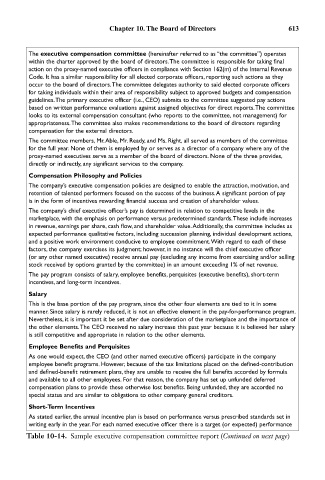Page 628 - Bruce Ellig - The Complete Guide to Executive Compensation (2007)
P. 628
Chapter 10. The Board of Directors 613
The executive compensation committee (hereinafter referred to as “the committee”) operates
within the charter approved by the board of directors.The committee is responsible for taking final
action on the proxy-named executive officers in compliance with Section 162(m) of the Internal Revenue
Code. It has a similar responsibility for all elected corporate officers, reporting such actions as they
occur to the board of directors.The committee delegates authority to said elected corporate officers
for taking individuals within their area of responsibility subject to approved budgets and compensation
guidelines.The primary executive officer (i.e., CEO) submits to the committee suggested pay actions
based on written performance evaluations against assigned objectives for direct reports.The committee
looks to its external compensation consultant (who reports to the committee, not management) for
appropriateness.The committee also makes recommendations to the board of directors regarding
compensation for the external directors.
The committee members, Mr.Able, Mr. Ready, and Ms. Right, all served as members of the committee
for the full year. None of them is employed by or serves as a director of a company where any of the
proxy-named executives serve as a member of the board of directors. None of the three provides,
directly or indirectly, any significant services to the company.
Compensation Philosophy and Policies
The company’s executive compensation policies are designed to enable the attraction, motivation, and
retention of talented performers focused on the success of the business.A significant portion of pay
is in the form of incentives rewarding financial success and creation of shareholder values.
The company’s chief executive officer’s pay is determined in relation to competitive levels in the
marketplace, with the emphasis on performance versus predetermined standards.These include increases
in revenue, earnings per share, cash flow, and shareholder value.Additionally, the committee includes as
expected performance qualitative factors, including succession planning, individual development actions,
and a positive work environment conducive to employee commitment.With regard to each of these
factors, the company exercises its judgment; however, in no instance will the chief executive officer
(or any other named executive) receive annual pay (excluding any income from exercising and/or selling
stock received by options granted by the committee) in an amount exceeding 1% of net revenue.
The pay program consists of salary, employee benefits, perquisites (executive benefits), short-term
incentives, and long-term incentives.
Salary
This is the base portion of the pay program, since the other four elements are tied to it in some
manner. Since salary is rarely reduced, it is not an effective element in the pay-for-performance program.
Nevertheless, it is important it be set after due consideration of the marketplace and the importance of
the other elements.The CEO received no salary increase this past year because it is believed her salary
is still competitive and appropriate in relation to the other elements.
Employee Benefits and Perquisites
As one would expect, the CEO (and other named executive officers) participate in the company
employee benefit programs. However, because of the tax limitations placed on the defined-contribution
and defined-benefit retirement plans, they are unable to receive the full benefits accorded by formula
and available to all other employees. For that reason, the company has set up unfunded deferred
compensation plans to provide these otherwise lost benefits. Being unfunded, they are accorded no
special status and are similar to obligations to other company general creditors.
Short-Term Incentives
As stated earlier, the annual incentive plan is based on performance versus prescribed standards set in
writing early in the year. For each named executive officer there is a target (or expected) performance
Table 10-14. Sample executive compensation committee report (Continued on next page)

